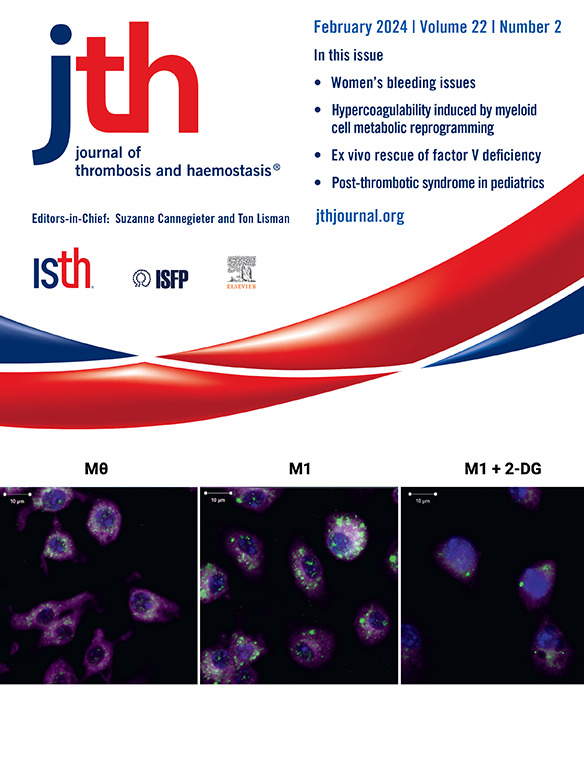儿童直接口服抗凝剂(DOAC)治疗静脉血栓栓塞试验的设计、方法和患者人群特征的系统分析。
IF 5.5
2区 医学
Q1 HEMATOLOGY
引用次数: 0
摘要
儿科直接口服抗凝(DOAC)试验提供了一个评估和描述其设计和执行中的挑战的机会,为未来的抗血栓试验提供信息。目的:对治疗静脉血栓栓塞的儿科DOAC试验进行系统回顾,以批判性地评估其方法,并了解其可行性和挑战。方法:系统检索MEDLINE、EMBASE、Cochrane图书馆和ClinicalTrials.gov(2002年1月至2022年12月)。研究报告了DOAC治疗儿童急性静脉血栓栓塞的介入试验结果,以及他们各自的设计论文。临床试验网站审查了试验注册信息。在研究设计、目标人群、样本量和分析计划和实际试验行为之间的差异进行了定性检查。结果:纳入了5项已发表的研究和另外2项未发表的试验数据。所有试验都对其设计或方法进行了修改,并且试验注册与最终发表的研究之间存在差异,这表明可行性存在挑战。所有试验均确定了资格标准的修改、样本量的变化、招募年轻患者的挑战以及入组人群与临床目标人群不匹配。结果报告的差异,特别是次要终点,也很常见。结论:DOAC试验经历了可行性挑战,导致了设计或方法的修改。未来的儿科抗血栓试验需要在设计上具有适应性,优先招募年龄较小的儿童,并从为目标人群提供护理的临床医生那里获得信息,确保入组人群与临床人群相匹配,并选择有临床意义的终点。本文章由计算机程序翻译,如有差异,请以英文原文为准。
Systematic analysis of the design, methodology, and patient population characteristics of the pediatric direct oral anticoagulant trials of venous thromboembolism treatment
Background
The pediatric direct oral anticoagulation (DOAC) trials provide an opportunity to evaluate and characterize challenges in their design and execution to inform future antithrombotic trials.
Objectives
To perform a systematic review of pediatric DOAC trials for the treatment of venous thromboembolism to critically appraise their methodology and understand the feasibility and challenges.
Methods
We performed a systematic search of MEDLINE, EMBASE, the Cochrane Library, and ClinicalTrials.gov (January 2002 to December 2022). Studies reporting the results of interventional trials of a DOAC for the treatment of acute venous thromboembolism in children and their respective design papers were included. Trial registration information was reviewed in ClinicalTrials.gov. Discrepancies in study design, targeted populations, sample size, and analyses between planned and actual trial conduct were examined qualitatively.
Results
Five published studies and unpublished data for 2 additional trials were included. All trials had modifications to their design or methodology and discrepancies between the trial’s registration and the final published study, suggesting feasibility challenges. Modifications to the eligibility criteria, changes in sample size, challenges with the recruitment of younger patients, and an enrolled population not matching the clinical target population were identified for all trials. Discrepancies in outcome reporting, particularly for secondary endpoints, were also common.
Conclusion
DOAC trials experienced feasibility challenges that led to design or methodology modifications. Future pediatric antithrombotic trials will need to be adaptive in their design, prioritize enrollment of younger children and input from clinicians providing care to target populations, ensure that enrolled populations match the clinical population, and select clinically meaningful endpoints.
求助全文
通过发布文献求助,成功后即可免费获取论文全文。
去求助
来源期刊
CiteScore
24.30
自引率
3.80%
发文量
321
审稿时长
1 months
期刊介绍:
The Journal of Thrombosis and Haemostasis (JTH) serves as the official journal of the International Society on Thrombosis and Haemostasis. It is dedicated to advancing science related to thrombosis, bleeding disorders, and vascular biology through the dissemination and exchange of information and ideas within the global research community.
Types of Publications:
The journal publishes a variety of content, including:
Original research reports
State-of-the-art reviews
Brief reports
Case reports
Invited commentaries on publications in the Journal
Forum articles
Correspondence
Announcements
Scope of Contributions:
Editors invite contributions from both fundamental and clinical domains. These include:
Basic manuscripts on blood coagulation and fibrinolysis
Studies on proteins and reactions related to thrombosis and haemostasis
Research on blood platelets and their interactions with other biological systems, such as the vessel wall, blood cells, and invading organisms
Clinical manuscripts covering various topics including venous thrombosis, arterial disease, hemophilia, bleeding disorders, and platelet diseases
Clinical manuscripts may encompass etiology, diagnostics, prognosis, prevention, and treatment strategies.

 求助内容:
求助内容: 应助结果提醒方式:
应助结果提醒方式:


